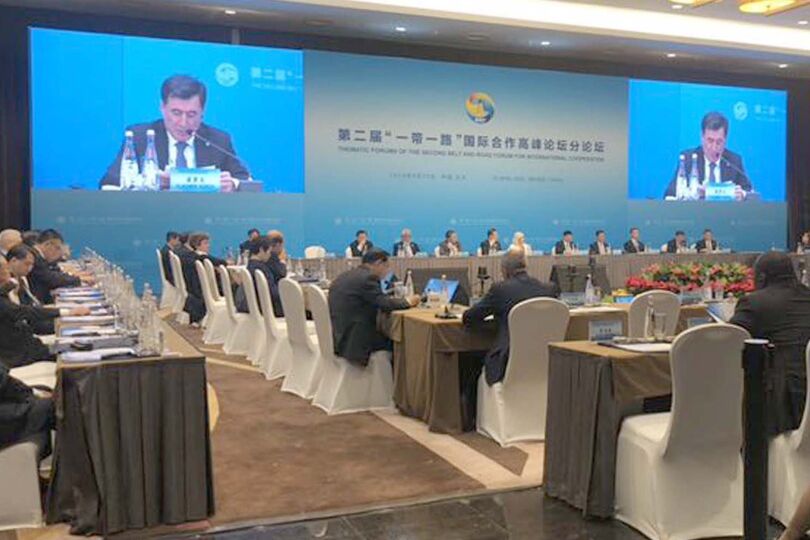Esteemed participants,
Ladies and gentlemen,
Ladies and gentlemen,
It is a great honour for me to take part in the Second Belt and Road Forum for International Cooperation.
Comprehensive cooperation on this major initiative set forth by Chinese President Xi Jingpin in 2013 is designed to pool the efforts of states on three continents with a view to confronting the challenges to stable and sustainable development facing the international community.
This global initiative can change the world for the better and create new opportunities for cooperation.
The Belt and Road initiative is a long-term multi-vector strategy for common development and prosperity. All states will gain from taking part in it.
The linking of the Belt and Road initiative with national economic development strategies of the SCO member states conforms to the goals, tasks and principles of our Organisation.
The main principles of the "Shanghai spirit" are also fully realised in this process.
Documents of the past three SCO summits fully support the Chinese initiative. The SCO countries emphasised that they will consistently enhance their efforts on its joint implementation with a view to fostering a broad, open, mutually beneficial and equitable partnership in the SCO space, as well as a common vision for creating a community of shared destiny for humanity.
Ladies and gentlemen,
Ladies and gentlemen,
The SCO's role in the success of the Belt and Road initiative is growing substantially, especially considering the geopolitical and geo-economic importance of the SCO space.
In its zone of responsibility, the SCO is acting as a guarantor of peace and stability without which it is impossible to carry out large infrastructure projects for the sustainable development and prosperity of the countries of the region and the entire Eurasian space. This fully conforms to Xi Jinping's view that "the implementation of the Belt and Road plans requires a peaceful and stable situation."
In order to ensure the long-term sustainable development of the countries and regions along the Belt and Road, enhancing transport and communications links and the connectedness of relevant infrastructure is an objective necessity.
The main routes of the Silk Road economic belt pass from China via Central Asia and Russia to Europe, as well as from China through Central and Western Asia to the Persian Gulf and the Mediterranean.
Today, the SCO member states are actively joining these efforts.
Thus, in May 2015 President of Russia Vladimir Putin and President of China Xi Jingpin signed an agreement on linking the Belt and Road and the Eurasian Economic Union (EAEU), aimed at creating a vast transit zone for cargo flows from Asia to Europe and back, and for joint production facilities and exports of goods from the SCO member states to China's vast market.
In addition, cooperation on linking the Belt and Road initiative to national economic development strategies opens up broad prospects for Central Asian countries, as the nucleus of the SCO, to address the strategic task of gaining direct access to seaports and transforming the region into a major crossroads of transcontinental routes from East to West and from North to South.
This is exactly why the strategy for the SCO's development until 2025 pays priority attention to projects that enhance transport and communications opportunities, as well as to the development and modernisation of infrastructure, the establishment of international multi-modal logistics centres and the formation of a network of industrial clusters along transport routes.
In addition, at the summit in Qingdao, the presidents of the SCO member countries laid special emphasis on the importance of enhancing multilateral cooperation in automobile and railway transport, including high-speed roads, and introducing innovation technology.
The SCO member states closely cooperate with the Silk Road Fund and the Asian Infrastructure Investment Bank to ensure the funding of joint infrastructure projects. They are important financial instruments for implementing the Belt and Road initiative.
Ladies and gentlemen,
Ladies and gentlemen,
Some 15,000 high-speed roads and over 244,000 railways in the SCO countries are facilitating the expansion of trade and economic cooperation and promoting regional transport links.
Making effective use of the transit potential of the vast SCO space by removing all kinds of barriers in the way of international shipments, developing multi-modal transregional logistics hubs and forming the required institutional basis for linking infrastructure projects of SCO member states and the Belt and Road initiative is bound to promote the socio-economic progress of our nations.
Thank you for your attention.
The panel session on infrastructure connectivity at the Second High-Level Belt and Road Forum for International Cooperation took place in Beijing on 25 April 2019.
It was attended by the heads of relevant ministries and departments of the People's Republic of China, the Republic of Serbia, the Democratic Republic of Timor-Leste, the Czech Republic, Jamaica, the Republic of Kazakhstan, the Republic of Kenya, the Lao People's Democratic Republic, the Republic of the Union of Myanmar, the Islamic Republic of Pakistan, the Republic of the Philippines, the Republic of Singapore, the Kingdom of Thailand, the Kingdom of Cambodia, the Republic of Azerbaijan, the Republic of the Congo, Malaysia, the Republic of Malta, Mongolia, the Federal Democratic Republic of Nepal, Papua New Guinea and the Democratic Socialist Republic of Sri Lanka, as well as representatives of international organisations.
